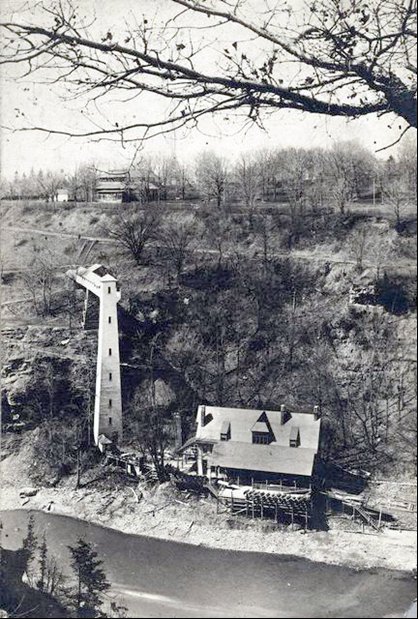From:
Times-Union May 6, 1922
Do You Remember
Maplewood Pleasure Park
And Glen House Elevator

The above picture not only gives a comprehensive view of the old Glen House and the hydraulic elevator which carried passengers from Buell avenue to the river bank, but also shows the buildings of Maplewood between Lake avenue and Buell avenue, on the sire which has been for more than 60 years a playground for Rochesterians.
In the late '60s Maplewood was used as a general picnic ground and a beer garden. It was considered to be practically in the country and the stretches of meadow under the great maples and oaks formed a natural recreation ground. The buildings seen in the picture, just above the top of the elevator, were used as a dance pavilion, music hall and band stand. The annual labor day processions usually ended at Maplewood with races and other games and many a Fenian gathering was held beneath the big tree.
In 1871 the place was operated as a beer garden and for a time ran wide open on Sundays until the neighbors became scandalized at certain happenings and a campaign was started to close the buildings, at least on Sundays. The controversy waxed to white heat, the newspapers took it up and printed letters and editorials for and against the closing movement, the politicians became involved and the climax came when two prominent citizens of the "Old Tenth Ward" came to blows in a Lake Avenue street car, words having failed to express their feelings on the matter.
In 1872 the recreation grounds passed into other hands and the mane was changer to Maple Grove under which title it came churches and societies as a picnic grounds. In the 90's the grove was surrounded by a high board frnce. This was removed when the property was acquired by the Rochester Park Board in 1904.
The Glen House was built in 1870 for Woodworth, Ellwanger and Barry on property they had purchased from Dr. Kelsey. It was for some time conducted by Aaron Bennett and was a favorite resort for Rochesterians. Excellent meals were served in the big dining room and there were nightly dances during the summer on the big veranda facing the river. It was also the starting point for boating parties and for the steamers which ran to Charlotte.
On May 4, 1894, the building was destroyed by fire. Mr. and Mrs. Jacob Valley, who were then in charge of the building, escaped but Mrs. Valley's mother was overcome by smoke and perished in the flames. Great difficulty was experienced by the firemen fighting the fire owing to the steep descent to the building. A hose was finally dropped down the shaft of the elevator but the flames had gained such headway that by morning only the stone pillars and the outer walls of the Glen House remained.
The hydraulic elevator was one of the wonders of Rochester in its day and was almost as temperamental as "Old Calamity," the West avenue canal bridge. Its eccentricities became so alarming toward the last that timid persons preferred to make their way pantingly up the hundreds of steps built up the side of the river bank rather than trust themselves to its whimsies. A final escapade in which it dropped half the length of the elevator shaft and bounced back again while carrying a load of school children resulted in its being closed.
The original of the picture above was loaned to The Times-Union by Charles M. Rowe of the Rochester Camera Exchange. It seems probable that it was taken from the east bank of the river in the rear of the Institute for Deaf Mutes.